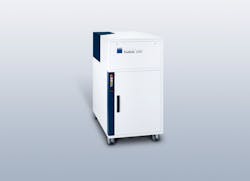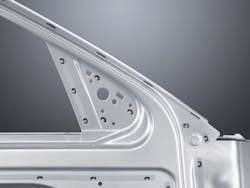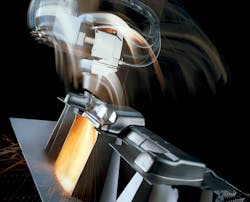The disk laser continues to exceed expectations in industrial implementation. Fast approaching 6000 high-power disk laser installations, with demand upwards of 2000 lasers per year, the disk laser has proven to be a robust and reliable industrial tool. Ongoing increases in power per disk, beam quality, and efficiency, combined with ever-increasing choices in ultrafast pulse and alternate wavelengths like ultraviolet and green, not only prove the flexibility of the disk laser concept, but also have dramatically increased its utilization for material processing. Disk lasers are found in applications from tens of watts to over 30kW, and from femtosecond pulses to continuous-wave (CW). These lasers are used in material processing applications such as cutting, remote cutting, conduction welding, conventional welding, remote welding, heat treating, laser metal deposition, drilling, ablation, and surface cleaning, and are found in a large variety of industries.
In the summer of 2012, TRUMPF launched the CW 6kW smaller, higher-efficiency disk lasers that set the standard with improved cost-effectiveness (FIGURE 1). With beam qualities from 2mm-mrad and up, and powers up to 16kW, the disk laser addresses a broad range of industrial applications. The range begins with micro-processing and extends to, but does not end with, multi-kilowatt applications in the thick plate range. Let's consider just a few of the most important CW applications.
High-speed cutting of thin sheets
In the thin sheet area, the 1μm wavelength of the disk laser enables higher cutting speeds compared to the 10μm wavelength of CO2 lasers. For many years, 1μm lasers have been used for cutting foils and thin sheets with thicknesses up to 2mm, including everything from electronic components to decorative stainless steel shades in the lighting industry. Because of the improved brightness of the CW disk laser, cutting speeds have increased significantly. Although the fundamental cutting speed has increased, the cut quality of small contours and edges can be less than desirable if not properly addressed. The handling system, such as a robot or gantry system, can't keep up with the high velocities while maneuvering small features and tiny contours. If the cutting parameters are not changed, an increase in heat input results, which can lead to excessive burning and poor cut quality. One strategy to reduce this effect is to lower the CW output power proportional to the cutting speed. However, since this technique reduces the power intensity, the cut quality often suffers. The best approach is to gate or pulse the power relative to the speed to reduce the overall heat input without compromising beam intensity.
Disk lasers have also been integrated into TRUMPF's flat sheet cutting machines, and as of today, the disk laser has virtually supplanted the CO2 laser as the tool of choice for flat sheet laser cutting operations. Customers want the higher productivity provided by the 1μm disk laser and they don't have to give up any flexibility or quality when cutting thick materials.
Fine welding of thin foils
Besides high beam quality, the high dynamics of the laser source is of primary importance for welding thin foils with high accuracy. Coupling of a 1kW disk laser with programmable focusing optics (PFOs, such as galvanometer-based X-Y scanner optics) allows for high-speed and highly reproducible welding of thin foils up to a few tenths of a millimeter thick. In this way, the disk laser has been used for applications such as welding EV battery connections, fuel cell assemblies, sensors, valve diaphragms, airbag inflator burst disks, and medical device components.
Welding in powertrain
Laser welding of powertrain components, including torque convertors, gears, drive shafts, and differentials, has been standard practice with CO2 lasers for many years. In recent years, however, the disk laser has been implemented for such applications due to its high power and excellent beam quality, as well as impressive savings compared to joining with a CO2 laser. The reason is twofold: On the one hand, there is savings in electrical consumption. The CO2 laser achieves approximately 8–10% wall plug efficiency (WPE), whereas the disk laser boasts a WPE in the range of 30%, or even a bit higher, depending on the model. However, this cost savings is almost insignificant when compared to the savings in shield gas. Welding with the CO2 laser requires costly helium, but with the disk laser, a shield gas is not required. If one is desired, the much cheaper and more readily available argon can be used. The typical maximum weld penetration for powertrain components is about 8mm, which the disk laser readily produces, along with a very high aspect ratio. This proves to be an ideal combination for a powertrain's concentric and rotating parts, which demand a low-distortion joining process (FIGURE 2).Hybrid laser welding with high laser power
Industrial applications of hybrid laser welding have been found in a variety of industries for many years. Historically, while the lamp-pumped solid-state laser dominated low-power applications, high-power applications were dominated by CO2 lasers. This began to change in 2007 when disk laser advancements brought about higher output powers and enabled it to enter the thick sheet regime. Eight years ago, the first 10kW disk lasers were delivered, and since then they have been serving hybrid laser applications such as welding of truck axles, poles, and panels for large ships. The laser hybrid welding process offers a lot of advantages over either laser or arc welding alone, like increased welding speed with greater sheet thicknesses, higher process efficiency, and reduced heat input into the material. Therefore, thermal distortion can be minimized. In addition, the combination of laser and arc welding is able to bridge a larger fit-up gap, as compared to welding with the laser beam only.
The main advantage of the disk laser compared to CO2 lasers is found in its capability of guiding the laser beam with a flexible fiber. This enables simplified integration of the laser into both the motion system and the arc welding process.
Laser scanner welding
Remote laser welding is one of the most common and successful global applications of the disk laser. Many automotive companies, as well as suppliers (e.g., the seat industry), rely on disk laser technology and have integrated remote welding into their production lines. Some of the well-known applications can be found at Daimler, as well Audi and Volkswagen.
The biggest advantage of the remote welding process is extremely high productivity. Unproductive times between welds can be essentially eliminated. Therefore, the laser, as a welding tool, can be used in the most efficient way possible. While the laser on time of conventional laser welding applications is about 30–40%, the remote laser process enables laser on times of up to 90%. In comparison to conventional resistance spot welding, the process speed can be increased by a factor of 3 to 10 times.
Another advantage of laser remote welding is its high flexibility. The geometry of the seam can be adapted to the actual stresses at the weld joint, which enables optimized component design. In addition, the seam geometry can be adapted to the situation. While a slim flange leads to slim C-shape or a linear weld, broader C-shapes can be chosen if the space allows for such geometries (FIGURE 3).Laser cutting of hot-formed steel
An extremely important and growing market is the cutting of hot-formed components. These components are used in the automotive sector for their ability to decrease mass and increase passenger safety. Because of the extremely high tensile strength of hot-formed components (typically greater than 1500MPa), conventional shearing tools wear too quickly and sheared edges are often plagued with micro-cracks. As a result, laser processing is the only viable method for cutting hot formed parts in high-volume production. For this market, high-beam-quality (4mm-mrad) 3 and 4kW disk lasers are coupled with a multi-axis system design by TRUMPF specifically for the hot-formed cutting market. The excellent beam quality and short wavelength, combined with the highly dynamic and robust system, enable and easily deliver high throughput in the extremely demanding and harsh automotive manufacturing environment (FIGURE 4).Conclusion
A couple years ago, developers at TRUMPF pumped a single 0.5in.-diameter disk with diode modules and produced over 10kW of laser power. They wanted to see how the disk would respond, and after taking it through a rigorous testing protocol, they found the disk and the laser performed very well together.
Conservative calculations show that a single disk is capable of producing well over 30kW of CW laser power. Other calculations show that 50kW is possible. Whatever the limit, the disk principle has not yet come close to reaching any fundamental limit regarding output power per disk. Furthermore, with continual advancements in beam quality, running cost, investment cost, and footprint, the disk laser is certain to play a pivotal role in laser material processing for many years to come.



